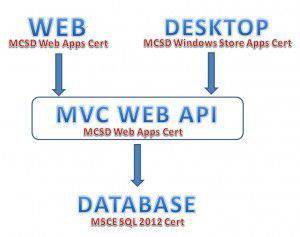Working in a software development house, I am greeted every morning by what I like to call “the wall of success”. It’s an ordinary wall made from ordinary plaster, yet it houses a feat of accomplishments. Degrees, diplomas, certifications and awards hang proud in testament to the time and effort taken to achieve them.
In business, as in life, it takes on-going learning and skills development to move forward and succeed in fast-changing environments. As the needs of business change in a world fast becoming an information system, the key to “staying on top” requires a lot more than clever business strategies, the key is differentiation. Distinguishing oneself with technically skilled teams I believe is essential in delivering cutting edge products – highly qualified people with the ability to implement new technologies that allow business to leverage their information systems in an optimal way.
In a Nutshell: Qualified staff + a broad skills base + new tech = cutting-edge products and happy customers!
Culture of Learning…
Inspiration (in·spi·ra·tion) noun – a result of inspired activity…
As any writer would tell you there are days when the words just don’t flow, when inspiration is AWOL and the strongest of coffee just doesn’t do the trick. It’s on those days that I gaze up at the wall, and draw incentive. At KRS the focus is strongly on the “best tool for the job” which in this context doesn’t just apply to the technology used but more the theory around the best way to use the tools. Staff are encouraged to regularly develop relevant skills that will provide them with the knowledge and competencies required to stay current and perform at a certain level.
Ours is a culture of learning, which in the Agile world is one of continuous motion. Staying current in the Microsoft track of certifications, Scrum Master and Agile endorsements, post-graduate degrees and diplomas, all-the-while embracing new tech and implementing these successfully, require an ethos of on-going commitment.
As a Microsoft Partner with awards across the competencies of Data Platform and Application Development, we understand the importance of relevance with the tools and technologies on offer.
Applied Skills…
Using separate teams that split the effort between the User Interface and Backend components we are able to combine the strengths of different skills across all competencies.
Currently our developers are engaging in another round of certifications across 3 different Microsoft tracks – we believe that a broader skills base is necessary to help developers stay relevant as technology solutions advance.

The Value Factor
I spent some time picking the brains of both our architects and developers taking on these certifications and thought I’d highlight a few of the values our learning ethos brings to the various components of our system design and implementation:
Database side:
- Developers are easily able to model a business’s domain making for simpler communication of requirements and maintenance of the application.
- Leveraging technologies such as Entity Framework enable developers to easily access data, ascertain needs and translate those needs into code. This tool allows our developers to express the code in a language similar to your business.
- Retrieving information from a database takes time; developers who know how to design databases to support increasing volumes benefit business in scalability – a highly efficient database means a better user experience and increased productivity.
- With an understanding of existing components, developers are able to simplify the coding process thereby saving time.
User Interface side:
- Developers are able to create richer interfaces with less effort than before using more advanced technologies to deliver better user experiences.
- Through certifications developers learn how to deliver professional solutions on time and within budget.
- With a focus on mobile applications development, cloud technology and the likes, business is now more than ever able to reach a wider market and drive competitive differentiation.
User Experience (UX) side:
The concept of the “User Experience” broadly centres on a user’s encounter with a system; the application of user-centred design practises to generate desirable human-computer interaction. In saying that our focus here is to:
- Incorporate more user-centred design and other UX principles into the front-end and at business level to positively influence the way we design the domain.
- By using fast proto-typing (in User Interface development) developers are able to create testable models quickly which allow for more thorough usability testing on those models.
Certified Success
I’m looking up at our “wall of success” again thinking to myself that soon the space will run out as the next round of certifications start to go up. In fact I think the wall may extend into other areas of our workspace, a reminder of our achievements, the inspiration we look for when technology calls.
Good luck to all of our 30+ developers going for it in this new round of certs!
About the Author:
Illana Graff is a Business Analyst, Technical Writer and Blog Editor at KRS. When she isn’t writing she can most certainly be found 4×4’ing somewhere…


